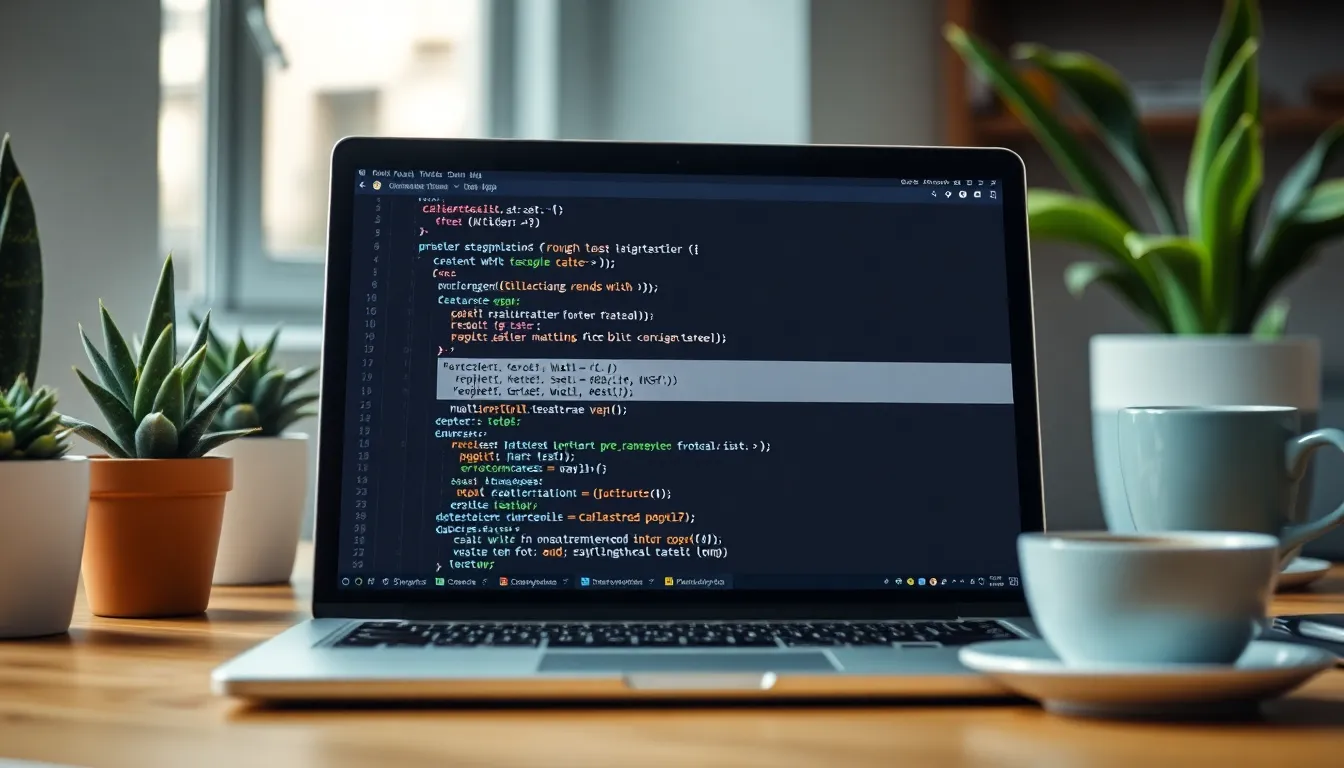Table of Contents
ToggleIn the vast universe of JavaScript, where strings twirl and dance like a caffeinated octopus, knowing how to check if a string ends with a specific character or substring can save the day. Enter the endsWith() method, the unsung hero of string manipulation. It’s like the superhero cape for your code, swooping in to help you verify endings without breaking a sweat.
Overview of Javascript EndsWith
The endsWith() method plays a crucial role in JavaScript string manipulation. This method checks whether a string concludes with a specified substring or character. Developers often leverage endsWith() for operations like validation, filtering, or formatting text.
Syntax for using endsWith() is straightforward. It takes two parameters: the target substring to check for and an optional position parameter that specifies where to begin the search. When the position parameter isn’t provided, the search defaults to the end of the string.
The method returns a boolean value—true if the string ends with the specified substring and false otherwise. For example, calling "Hello World".endsWith("World") returns true, while calling "Hello World".endsWith("Hello") returns false.
Using endsWith() enhances code readability and efficiency. Consider file extensions in URL validation, where checking for .jpg or .png simplifies filtering image paths. This method supports various scenarios, including user input validation and content formatting.
Understanding this method leads to better string handling practices in JavaScript. Efficiently checking endings can reduce complications in string processing, thereby streamlining overall functionality within web applications. As a result, adopting endsWith() contributes significantly to clean and efficient code.
Syntax of EndsWith Method

The endsWith() method in JavaScript provides a straightforward way to determine if a string concludes with a specific substring. This syntactic structure allows for efficient string manipulation.
Parameters
The endsWith() method accepts two parameters. The first parameter is the target substring, which is the string to search for at the end of the main string. An optional second parameter specifies the position to begin the search. If this parameter is omitted, the search starts from the string’s full length. For instance, using this method to confirm file extensions in URLs is common and effective.
Return Value
The return value of the endsWith() method is a boolean. This method returns true if the string ends with the specified substring and false otherwise. Such a return value is valuable for validation tasks, enhancing code logic and ensuring the expected string formatting. Employing this method can lead developers to write cleaner and more efficient code.
Practical Examples
The endsWith() method enables various practical applications in JavaScript.
Basic Usage
To check if a string ends with a specific substring, the syntax involves calling string.endsWith(searchString[, position]). For instance, if the string is “Hello, world!” and the target is “world!”, the method returns true. When the optional position is included, it limits the search to that indexed length. For example, str.endsWith("Hello", 5) returns true, verifying that “Hello” indeed concludes at the fifth character index. This functionality proves useful for validating file extensions or ensuring specific formatted strings.
Chaining EndsWith
Chaining methods can enhance JavaScript code flexibility. One can combine endsWith() with other string methods like trim() or toLowerCase(). Instead of just checking, a developer might first trim whitespace using str.trim().endsWith("txt"). This expression checks if, after removing whitespace, the string ends correctly with “txt”. Chaining allows developers to streamline checks and avoid redundant variables, promoting cleaner, more efficient code practices.
Common Use Cases
The endsWith() method in JavaScript finds application in various scenarios. Its ability to validate strings simplifies many coding tasks.
String Validation
String validation benefits significantly from the endsWith() method. Developers can easily check if a string adheres to specific formats. For example, file validation becomes straightforward when verifying extensions. A developer might use filename.endsWith('.jpg') to confirm a valid image file type. This method supports other validations, such as ensuring URLs conclude correctly. By using endsWith(), they enhance the application’s reliability while managing input effectively.
Filtering Data
Data filtering frequently involves the endsWith() method. This method allows developers to process lists of strings based on their endings. For instance, filtering an array of email addresses often requires checking relevant domains. A simple code snippet like emails.filter(email => email.endsWith('@domain.com')) retrieves all matching emails. Implementing endsWith() in this manner reduces complexity and improves code readability. Furthermore, it promotes efficient data manipulation, enabling developers to focus on critical aspects of their applications.
Performance Considerations
Performance of the endsWith() method impacts applications directly. Checking the end of a string can seem straightforward, but large datasets may affect efficiency. Calling endsWith() multiple times in a loop can lead to slower execution, especially with long strings.
Memory consumption presents another factor. Each call to endsWith() creates internal operations that may increase resource usage. Relying on this method across extensive data sets can lead to performance bottlenecks. Developers should weigh potential impacts on application speed.
Utilizing the optional position parameter effectively can optimize performance. Specifying a start index reduces the search scope, improving speed, especially when working with known string lengths. Limiting searches to the relevant portion of a string decreases unnecessary computations.
Combining endsWith() with other string methods requires careful consideration. Chaining could improve code readability but adds layers of computation. It’s crucial to balance clarity with efficiency in performance-sensitive applications.
Benchmarking various approaches demonstrates differences in execution times. Comparing endsWith() with alternative methods such as substring checks or regex can yield insights into the most effective implementation. Structured tests provide valuable data for developers aiming to enhance performance in their code.
Ultimately, optimizing performance while using endsWith() enhances applications. Thoughtful implementation leads to smoother user experiences. Understanding the method’s limitations and strengths supports informed decisions for efficient code.
Mastering the endsWith() method is essential for any JavaScript developer looking to enhance their string manipulation skills. Its ability to efficiently check string endings not only simplifies coding tasks but also improves code readability and performance. With practical applications in validation and data filtering, endsWith() is a versatile tool in a developer’s toolkit. By understanding its syntax and leveraging the optional position parameter, developers can optimize their code for better efficiency. Embracing this method can lead to cleaner code and a smoother user experience in web applications.




